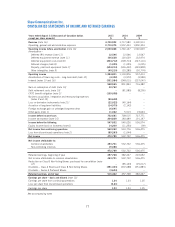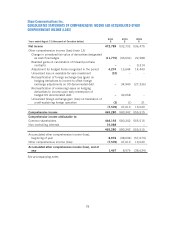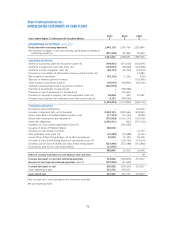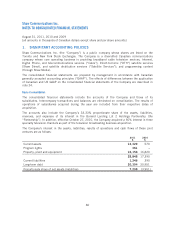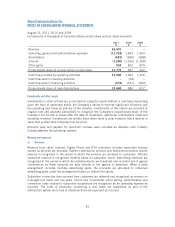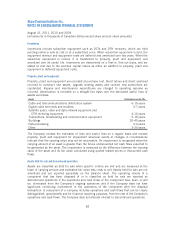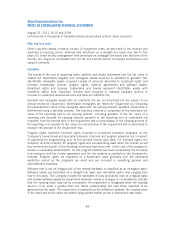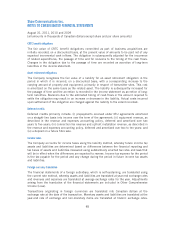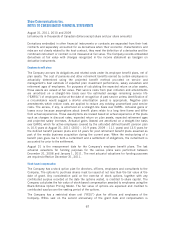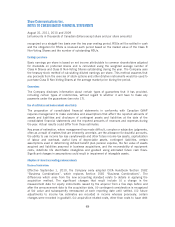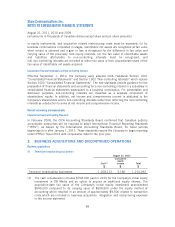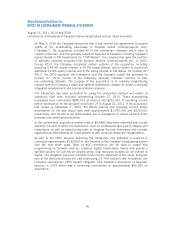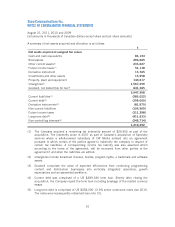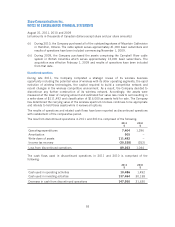Shaw 2011 Annual Report Download - page 91
Download and view the complete annual report
Please find page 91 of the 2011 Shaw annual report below. You can navigate through the pages in the report by either clicking on the pages listed below, or by using the keyword search tool below to find specific information within the annual report.Shaw Communications Inc.
NOTES TO CONSOLIDATED FINANCIAL STATEMENTS
August 31, 2011, 2010 and 2009
[all amounts in thousands of Canadian dollars except share and per share amounts]
Derivatives embedded in other financial instruments or contracts are separated from their host
contracts and separately accounted for as derivatives when their economic characteristics and
risks are not closely related to the host contract, they meet the definition of a derivative and the
combined instrument or contract is not measured at fair value. The Company records embedded
derivatives at fair value with changes recognized in the income statement as loss/gain on
derivative instruments.
Employee benefit plans
The Company accrues its obligations and related costs under its employee benefit plans, net of
plan assets. The cost of pensions and other retirement benefits earned by certain employees is
actuarially determined using the projected benefit method pro-rated on service and
management’s best estimate of expected plan investment performance, salary escalation and
retirement ages of employees. For purposes of calculating the expected return on plan assets,
those assets are valued at fair value. Past service costs from plan initiation and amendments
are amortized on a straight-line basis over the estimated average remaining service life
(“EARSL”) of employees active at the date of recognition of past service unless identification of
a circumstance would suggest a shorter amortization period is appropriate. Negative plan
amendments which reduce costs are applied to reduce any existing unamortized past service
costs. The excess, if any, is amortized on a straight-line basis over EARSL. Actuarial gains or
losses occur because assumptions about benefit plans relate to a long time frame and differ
from actual experiences. These assumptions are revised based on actual experience of the plans
such as changes in discount rates, expected return on plan assets, expected retirement ages
and projected salary increases. Actuarial gains (losses) are amortized on a straight-line basis
over EARSL which for active employees covered by the unfunded defined benefit pension plan
is 10.5 years at August 31, 2011 (2010 – 10.9 years; 2009 – 11.1 years) and 13.5 years for
the defined benefit pension plans and 14 years for post retirement benefit plans assumed as
part of the media business acquisition during the current year. When the restructuring of a
benefit plan gives rise to both a curtailment and a settlement of obligations, the curtailment is
accounted for prior to the settlement.
August 31 is the measurement date for the Company’s employee benefit plans. The last
actuarial valuations for funding purposes for the various plans were performed between
December 31, 2008 and January 1, 2011. The next actuarial valuations for funding purposes
are required effective December 31, 2011.
Stock-based compensation
The Company has a stock option plan for directors, officers, employees and consultants to the
Company. The options to purchase shares must be issued at not less than the fair value at the
date of grant. Any consideration paid on the exercise of stock options, together with any
contributed surplus recorded at the date the options vested, is credited to share capital. The
Company calculates the fair value of stock-based compensation awarded to employees using the
Black-Scholes Option Pricing Model. The fair value of options are expensed and credited to
contributed surplus over the vesting period of the options.
The Company has a restricted share unit (“RSU”) plan for officers and employees of the
Company. RSUs vest on the second anniversary of the grant date and compensation is
87


